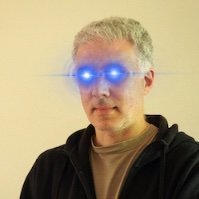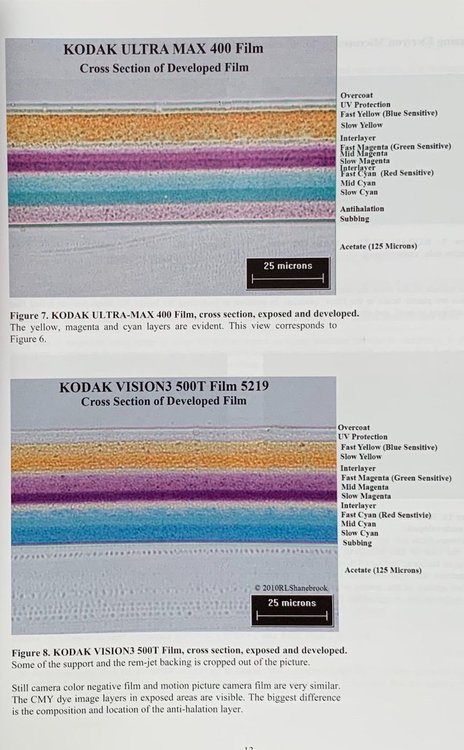-
Posts
478 -
Joined
-
Last visited
Everything posted by Karim D. Ghantous
-

Rotary prism cameras in Openheimer
Karim D. Ghantous replied to massimo losito's topic in General Discussion
That's nuts. -

Dynamic Range of 5248 film from 1952
Karim D. Ghantous replied to Jonathan Ruiz's topic in Film Stocks & Processing
That's correct, but my point was that if we can draw some equivalents, and use some half-decent logic, we can work our way back. E.g. if A is like B, and C is like D, and we know the differences between A and D, we can sort of figure out the relationship between B and C. Anyway, it's not going to be that simple, because we apparently have very little information about this. Ultra Max 400 and Vision3 500T have the same number of layers, more or less. From Making Kodak Film by Robert Shanebrook: Log curves might yield a clue, if we have them for any given stock: https://www.filmshooterscollective.com/analog-film-photography-blog/a-practical-guide-to-using-film-characteristic-curves-12-25 -

Rotary prism cameras in Openheimer
Karim D. Ghantous replied to massimo losito's topic in General Discussion
That is so cool. I wonder if digital cameras can get there one day? Perhaps sensor size will be the limiting factor. It wasn't that long ago that video cameras were limited to 30fps or less. Even very expensive ones. But some 8mm cameras from the 1930s could reach 64fps. -

Dynamic Range of 5248 film from 1952
Karim D. Ghantous replied to Jonathan Ruiz's topic in Film Stocks & Processing
We could estimate that by finding out how many layers those films had. Vision3 has three layers of each colour. Modern b&w film has two layers (I can't see why they can't have at least three?). Cheap 135 film like Kodak Color Plus maybe has two layers. I might have that info in a book somewhere. -
Even back before digital cameras and cheap post production, some DPs would use partial strength filters. They would then increase the strength in post. But, if for some reason they changed their minds, they could reverse the filtration if necessary. It was more for insurance than anything. It's much easier to use a filter IMHO. You can then view your dailies without having to pass them to a colorist. A bit of effort on set can save a lot of time in post.
-

Definition of „Cinematographer“?
Karim D. Ghantous replied to Joerg Polzfusz's topic in General Discussion
How the hell can a colorist call themselves a cinematographer? Unless of course they do both, as is the case with many people. -

Laser Graphic Director 10K vs 13K
Karim D. Ghantous replied to Boris Kalaidjiev's topic in Film Stocks & Processing
You have a point here. My question is more hypothetical. Remember, too, that long exposures don't eliminate shot noise (as far as I understand the concept). -

Am I crazy for not feeling 35mm film nowdays?
Karim D. Ghantous replied to Edith blazek's topic in General Discussion
I might go so far as to say that even Seinfeld looks better than a lot of modern movies or shows. Yes, it's not a cinematic masterpiece, but you can't beat 35mm - at least, you couldn't back then. I've been seeing clips of the show in HD (I don't have the Blu-Ray version yet) and it's amazing how much I like it, given how simply it was lit and shot. Thank God it wasn't shot on video. Thank God. And Sex & The City also looks terrific, while we're at it. -

Laser Graphic Director 10K vs 13K
Karim D. Ghantous replied to Boris Kalaidjiev's topic in Film Stocks & Processing
Yes, but if you didn't have the option of using different light intensities, I wonder if multi-sampling could be a decent substitute. -

Laser Graphic Director 10K vs 13K
Karim D. Ghantous replied to Boris Kalaidjiev's topic in Film Stocks & Processing
Perhaps a substitute for HDR scanning is multi-sampling? Just a thought. It would take longer though. -

Am I crazy for not feeling 35mm film nowdays?
Karim D. Ghantous replied to Edith blazek's topic in General Discussion
That was very nicely done, Tyler. How come Dave didn't get a credit? LOL Anyway, the image was very nice. Raw, but not unrefined. -

In Camera effects - Prisms, Glass...
Karim D. Ghantous replied to Boris Kalaidjiev's topic in General Discussion
Baltasar, that looks very cool. IMHO, if you try to do these things in post, you will spend too much time agonising about fine tuning. When you do it with filters, you have no choice but to accept what you shot. -

What actually is the "standard" budget? Then AND Now
Karim D. Ghantous replied to Max Field's topic in General Discussion
I am not a film professional, so I don't know anything. But is this of any help? https://beverlyboy.com/tv-commercial-production/how-much-does-it-cost-to-produce-a-commercial/ If you can do something for a price that's cheaper than you think it should be, then go with it. It might be tempting to inflate it, but just be careful of competition. -

Am I crazy for not feeling 35mm film nowdays?
Karim D. Ghantous replied to Edith blazek's topic in General Discussion
True, but I think there is something else: a lot of productions scan the negative. Which is great because it's the cleanest, purest version of the image. But, that's not the same thing as making a print, then scanning that. Prints don't really degrade the image as much as people think. But a print does add an extra dash of 'film-ness.' Bingo. I do wish that they would stop doing that. Let the film breathe and let it speak. People over-grade an image simply because they can. It's pathetic. -

Laser Graphic Director 10K vs 13K
Karim D. Ghantous replied to Boris Kalaidjiev's topic in Film Stocks & Processing
To repurpose the Castrol slogan, scanners ain't scanners. -

Laser Graphic Director 10K vs 13K
Karim D. Ghantous replied to Boris Kalaidjiev's topic in Film Stocks & Processing
I agree. 4-perf 35mm is about 4K worth of detail unless your lenses are super sharp and you're using slow film stock. But it isn't about detail. It's about making a digital version of the negative that's as close as possible to the original. -
They should have just made it black & white.
-
Uli that looks super interesting. I should give it a try, I think. Thank you.
-
Those scans are less grainy than a lot of 8-perf scans from photo labs. Imagine how good 35mm, delegated as a miniature format in photography, could be with proper scanning.
-

Future of Cinematography! What’s next?
Karim D. Ghantous replied to Saikat Chattopadhyay's topic in General Discussion
I agree. But we cannot put the cat back into the bag. Photography is slightly more boring now precisely because everything is so easy and so cheap. People say that cameras don't take photos, but that's bullshit, because they do a lot of the work for us now. That's just the way it is.- 32 replies
-
- cinematograhy
- technology
-
(and 1 more)
Tagged with:
-

Future of Cinematography! What’s next?
Karim D. Ghantous replied to Saikat Chattopadhyay's topic in General Discussion
No. Too expensive, too cumbersome. My go-to would be the Red 8K cameras for modern IMAX. And I mean full screen IMAX. Edit: You're right about needing more screens, too.- 32 replies
-
- cinematograhy
- technology
-
(and 1 more)
Tagged with:
-

Future of Cinematography! What’s next?
Karim D. Ghantous replied to Saikat Chattopadhyay's topic in General Discussion
IMHO, IMAX is the future. You don't need CGI, you don't need stars. You do need good cameras, but they are not exorbitant. You need good writing and good locations, too. And you can't get an IMAX-like experience in a typical home. I envision that IMAX features will be cheap to make, relatively speaking, and thus they will more easily turn a profit, even without a huge audience.- 32 replies
-
- cinematograhy
- technology
-
(and 1 more)
Tagged with:





